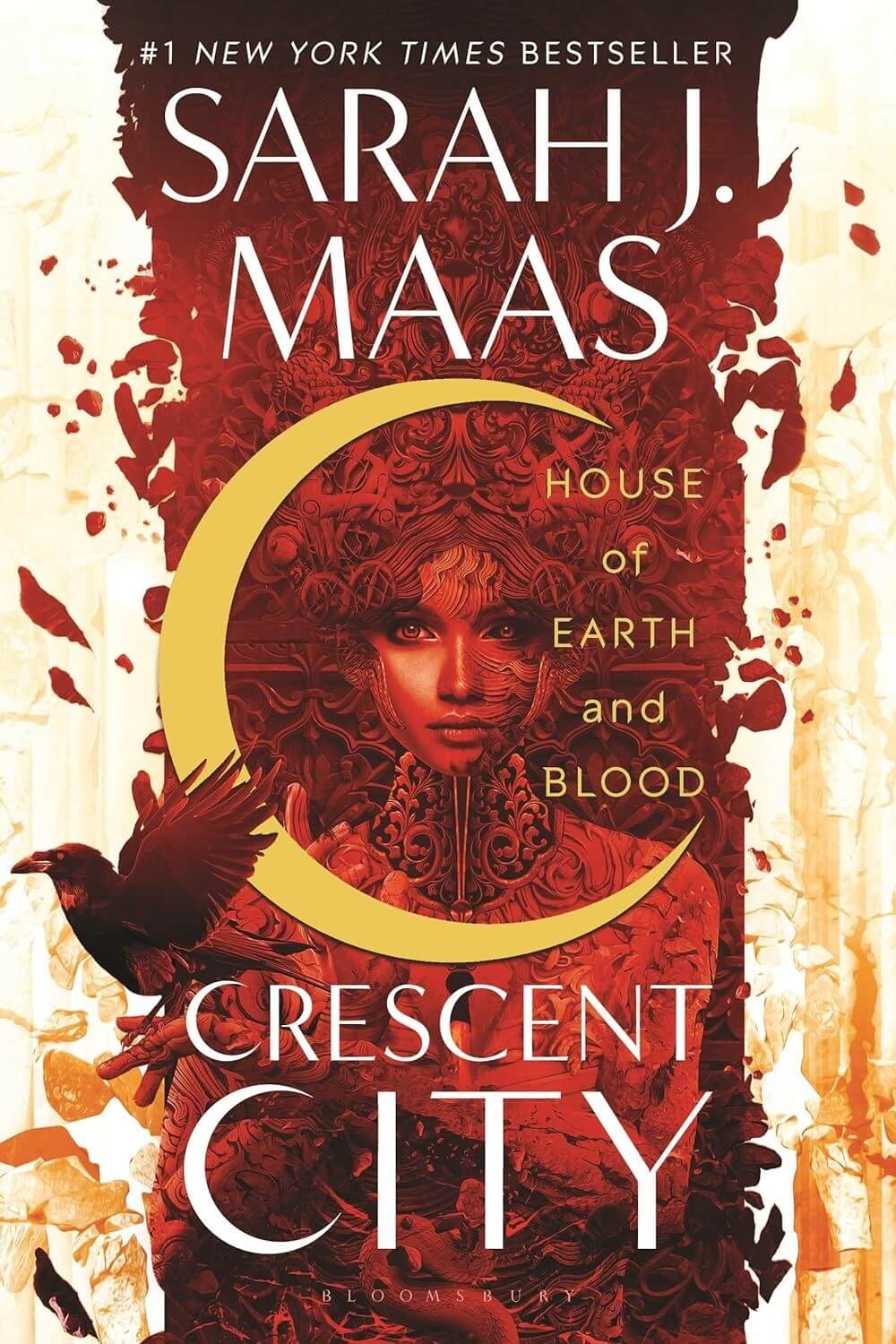
There’s a reason readers camp out at midnight releases and reread entire series before the next book drops. Sarah J. Maas books make people feel something. They’re emotional, immersive, and addictively readable.
And if you’re a fantasy writer trying to find your voice, her work shows that you don’t have to choose between writing for yourself and writing for the market. You can do both.
Her stories started as passion projects. Throne of Glass was drafted when she was sixteen. Now she’s one of the most influential fantasy authors of our time, with over 38 million copies sold worldwide and a fanbase that’s as loyal as it is loud. Her books hit hard because they’re personal.
Her characters struggle, heal, fall apart, and come back stronger, and her readers grow with them.
If you’re pouring your heart into your own fantasy novel and wondering if it’s too niche, too emotional, or too big, take a page from Maas.
She proved that epic worldbuilding and raw vulnerability can go hand in hand. And that kind of balance is worth studying. Let’s dig into how she pulls it off, and how you can, too.
A Quick Guide to Sarah J. Maas Books
Before we dive into the lessons, let’s take a quick look at the structure of her universe because understanding how her series are built will help you see why they work so well.
Throne of Glass
This YA fantasy series spans eight books and follows Celaena Sardothien, a deadly assassin with a complicated past. What starts as a prison-to-palace story turns into an epic journey filled with rebellion, ancient magic, shifting alliances, and female power that actually evolves.
It’s gritty, layered, and much darker than most YA fantasy. By the final book, the scope rivals any adult high fantasy series.
A Court of Thorns and Roses
Originally marketed as a Beauty and the Beast retelling, this adult fantasy romance morphs into something much deeper, and wildly more popular. Packed with fae courts, war strategy, slow-burn romance, and emotional recovery, the series has become a pillar of the fantasy romance genre.
And yes, it’s steamy. But the real hook is how Sarah J. Maas tackles trauma, survival, and emotional transformation with every major character.
Crescent City
This series pushes into urban fantasy, but still feels distinctly Maas. Set in a futuristic city powered by magical technology, it follows Bryce Quinlan, a half-fae who parties hard until her world is torn apart.
Think angels with guns, demons in glass towers, and government corruption tangled with ancient prophecy. The tone is sharper, the grief heavier, and the plot wrapped in a high-stakes murder investigation that blends fantasy with crime drama.
These books aren’t light reads. Most of them break the 600-page mark, some hitting nearly 800, and they’re packed with rich emotion, dense worldbuilding, high romance, and plot twists that hit like gut punches.
Write like you’re building a universe your readers will want to return to, and build your platform like you’re inviting them to live there.
Sarah J. Maas writes like she trusts the reader to keep up. And readers do, because the worlds she builds are worth sinking into.
If you’re writing fantasy fiction, especially with a long arc in mind, these series are worth studying for their scope alone.
The fact that millions of fans return to reread them, again and again, tells you something important: these stories are built to last. And that’s exactly where your writing lessons begin.
1. Build a Fantasy World That Feels Lived In
Maas doesn’t give you a map and a monologue. She throws you straight into a world where the tension is already brewing, the alliances already shifting, and the history already scarred.
You’re not standing at the gates waiting for a tour. You’re already inside, piecing things together as you go. And that’s what makes it immersive.
What makes Sarah J. Maas books so compelling is how the world unfolds layer by layer. You get a glimpse of old wars through a single bitter line of dialogue. You sense past betrayals from the way two characters look at each other.
The lore creeps in through stories told by side characters, forgotten ruins, subtle symbols, and casual references to old rulers or lost cities. It’s never dumped on you. It’s woven into every scene.
This kind of drip-feed worldbuilding keeps even casual readers leaning in, trying to understand who holds power, what magic is feared, and what rules govern each realm. And when the big reveals do come, they hit harder because the clues were already there.
If you’re writing your own fantasy novel, you don’t have to create an encyclopedia before you write chapter one. Instead, focus on the parts of the world your characters actually experience.
Start with what shapes their daily lives: the beliefs they’ve grown up with, the things they’re forbidden to say, the places they avoid after dark. From there, you can build outward.
Try grounding your world in:
- Local customs that feel lived-in and tied to history
- Slang, dialects, or phrases that reflect social divisions or cultural pride
- Power shifts and consequences that ripple through everyday life, not just the palace halls
One of my clients, an online seller who pivoted to writing fantasy fiction, created a world where everything revolved around trade: import taxes, black-market auctions, forged guild stamps.
She treated her story’s economy the way some fantasy authors treat magic systems. And it worked. Her readers got invested because the stakes weren’t abstract; they were baked into the setting. When a forged shipping document could spark a war, people paid attention.
The key is to make every detail feel like it belongs, and that it matters. When your world has rules that echo through your plot, your readers won’t just follow your story. They’ll believe in it.

2. Write Characters Who Earn Their Power
Aelin. Feyre. Bryce. You meet them at their lowest. One is a prisoner. One’s a traumatized huntress. One’s barely surviving behind a party-girl mask.
They don’t open their stories swinging swords and saving kingdoms. They fight their way up from fear, failure, and self-doubt. That’s why readers connect with them.
Sarah J. Maas writes characters who bleed before they rise. Their strength doesn’t come from special powers or destiny alone. It’s forged in moments of collapse.
Every decision they make carries emotional weight. Every win costs them something. Whether it’s trust, love, control, or identity, they lose parts of themselves to grow into something stronger.
Her characters don’t just face external monsters. They battle trauma, shame, grief, betrayal, guilt, and loneliness, and those inner demons hit harder than the fae generals or magical beasts.
Readers come back to Sarah J. Maas books not just for the action, but because the characters feel human in the ways that matter most.
If you want your own characters to hit that same emotional depth, let them earn every ounce of their strength. You don’t need to throw them into war right away.
Put them in situations that test their values. Make them fail. Let them choose the wrong thing for the right reason, and deal with the fallout.
Want your characters to stand out? Give them:
- Moral struggles that force them to question what they believe
- A personal cost that comes with every win, whether emotional, physical, or relational
- Wounds that don’t fade overnight, even when the plot moves forward
I once worked with a client who was writing a sci-fi fantasy hybrid, and she was hesitant to make her main character too flawed. She worried readers wouldn’t root for someone so selfish at the start.
But after we leaned into it—gave her protagonist a deeper backstory, real regrets, and a turning point that actually made sense—readers loved it. Some even emailed her saying, “I didn’t think I’d like her. But by the end, I wanted her to win.”
That’s what happens when your character earns their power. They become real to the reader. And real characters don’t have to be perfect. They just need to grow in ways that matter.
3. Master the Slow Burn
Few authors can stretch romantic tension across multiple books like Sarah J. Maas. In ACOTAR, it takes three full novels before Feyre and Rhysand reach anything close to emotional stability, and even then, it’s shaky.
But that’s exactly why readers stay hooked. Every stare, every brush of the hand, every fight that’s almost a confession. It builds a kind of tension that’s hard to look away from.
Why? Because it feels earned. The payoff lands harder when you’ve taken readers through the pain, the hesitation, the unspoken truths.
You’re not rushing into chemistry. You’re building it, testing it, watching it evolve in real time. And when the kiss finally happens, it doesn’t feel like a reward. It feels like survival.
If you’re writing fantasy romance, learn to play with:
- Proximity without payoff – Put your characters near each other often, but don’t give them what they want right away. Keep them craving.
- Emotional intimacy before physicality – Let them open up in small ways: a secret shared, a protective gesture, an honest look when no one’s watching.
- Conflict that stems from character wounds, not just outside forces – Their baggage should shape how they love, fight, and pull away.
In my work with creators who sell romance-themed planners and book boxes, the stories that consistently sell out have one thing in common: slow-burn tension. Readers want to chase the romance, not have it handed to them.
The lore creeps in through stories told by side characters, forgotten ruins, subtle symbols, and casual references to old rulers or lost cities.
One creator I worked with centered her entire product line around “almost-love” moments: annotated quotes, missed connections, and character-driven longing. Her sales tripled after shifting the focus from steamy scenes to emotional build-up.
If you can write a moment where one character almost reaches for the other and then walks away, and your readers feel it in their chest? You’ve nailed it.
The trick is making every interaction matter. Every pause, every argument, every touch should pull the relationship forward, or tear it apart. When you let it burn slow, readers will follow you anywhere.
5. Write Strong Female Leads Without Making Them Perfect
Sarah J. Maas has taken heat and praise alike for her female leads. They’re sexy, powerful, vulnerable, reckless, and, at times, infuriating. They make questionable choices. They lash out. They break things they love and fix them with trembling hands.
And that’s the point. You’re not reading about role models. You’re watching real, complicated women try to survive, lead, and heal in worlds that are stacked against them.
In Sarah J. Maas books, the female protagonists don’t fit into neat categories. Aelin is both a queen and a killer. Feyre is both a survivor and a destroyer.
Bryce is both emotionally shattered and impossibly defiant. They cry, they seduce, they rage, and they strategize, and they do all of it without apologizing for who they are.
Her women are never tokens. They aren’t there to check boxes. They’re there to drive the story forward, and often, to burn it down and rebuild it on their terms.
If you’re writing female leads, avoid turning them into either:
- Emotionless warriors – Strength doesn’t mean silence.
- Helpless dreamers – Vulnerability doesn’t mean weakness.
Let your characters carry both. Power and pain can exist in the same sentence. The best scenes are often the ones where your heroine fails hard, questions everything, and still gets up.
One of the indie authors I worked with created a protagonist who led a rebellion and suffered from severe PTSD. Readers didn’t just root for her. They saw themselves in her. Her strength was earned not from physical victories, but from her emotional endurance.
As Sarah J. Maas books progressed, her cast also grew more inclusive. Characters like Nesta, Amren, and Emerie showed different shades of womanhood, while newer entries began to reflect LGBTQ+ identities with care and intention. That shift matters.
Aspiring authors should see diversity in fantasy not as a checkbox to tick, but as a reflection of the real world we live in, and the richer stories we can write when we pull from it. Your readers are hungry for characters who feel real, no matter their background.
So give them women who are messy, bold, terrified, brilliant, and strong in ways that aren’t always visible at first glance.
Learn from How She Markets Her Books
Sarah J. Maas didn’t just write her way to success. She marketed her way there, too. Long before Throne of Glass hit bookstores, it lived on FictionPress, where she uploaded chapters as a teenager.
The story already had a loyal fanbase by the time it landed on a publisher’s desk. That early traction wasn’t luck. It was built through years of visibility, engagement, and smart use of online platforms.
She didn’t stop once the book was published.
Her approach to marketing became just as layered as her worldbuilding. She used her email list to build anticipation. She dropped exclusive covers and teasers that fans would screenshot and share.
She leaned into fan art contests, countdowns, and Instagram Q&As that made her readers feel part of something bigger. By the time the next book launched, she didn’t need to chase an audience. They were already waiting.
What can you take from this?
- Start your audience early – Even if you’re still writing, talk about your book. Share your process. Let people care before it hits shelves.
- Create shareable moments – Think visuals, snippets, or inside jokes from your story. Give your readers something they’ll want to repost.
- Keep showing up online – Socials, email, your website—it all adds up. You’re building a presence, not just promoting a product.
I’ve worked with indie authors who sell on Etsy and run digital storefronts, and the ones who succeed with book launches are the ones who treat their books like a brand. One of my clients bundled her fantasy novel with character art stickers, themed candles, and exclusive maps.
She turned her book into a sensory experience. Her audience grew because the story didn’t stop at the page. It spilled over into her shop. Sales tripled, and her launch month became her highest-earning quarter.
Sarah J. Maas books inspire the same kind of loyalty. Fans preorder the hardbacks, then buy the special editions. They annotate chapters with colored tabs. They buy character-inspired jewelry.

Why? Because the world she built feels personal, and fans want to carry a piece of it with them.
If you’re an aspiring author, take the hint. Your marketing doesn’t have to be flashy or expensive.
But it does have to be consistent, thoughtful, and rooted in what your readers care about. Think like a storyteller and a brand builder.
Sarah J. Maas books work because they rest on solid foundations: unforgettable characters, immersive worlds, consistent pacing, and emotional truth.
You don’t need to write about fae or romance to learn from her success. What you should study is how deeply she understands her audience and how deliberately she serves them.
Some critics call her work indulgent. I call it calculated. She gives her readers what they crave, and she does it without apology. That’s smart writing, and even smarter marketing.
The lesson here is to write like you’re building a universe your readers will want to return to, and build your platform like you’re inviting them to live there. When your story feels like a world worth staying in, the rest—the buzz, the fan art, the preorders—has a place to land.




